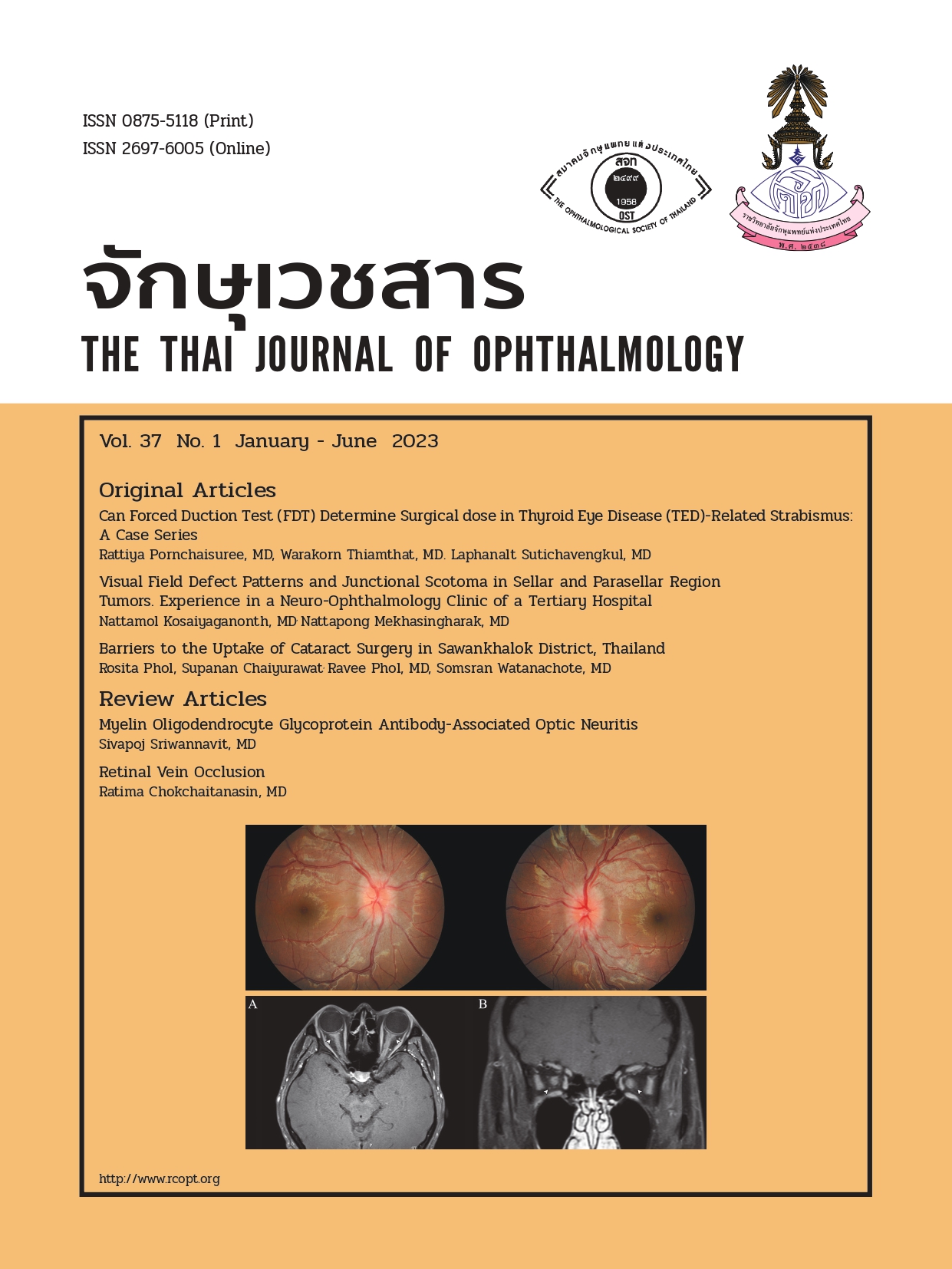Visual Field Defect Patterns and Junctional Scotoma in Sellar and Parasellar Region Tumors. Experience in a Neuro-Ophthalmology Clinic of a Tertiary Hospital
Keywords:
sellar region tumor, junctional scotoma, junctional scotoma of Traquair, visual field defectAbstract
Objective: To demonstrate the visual field defect patterns of patients with sellar and parasellar region tumors in a tertiary neuro-ophthalmology clinic.
Methods: The data of all patients in the neuro-ophthalmology clinic at Naresuan University Hospital who presented with visual loss and were diagnosed with sellar/parasellar region tumors over 4 consecutive years were retrospectively reviewed. Visual fields (VF) were tested by the Humphrey Visual Field Analyzer 24-2 or 30-2 and were categorized into 5 groups: junctional scotoma (basic), junctional scotoma of Traquair, bitemporal defect, diffused loss in only one eye, and others.
Results: Among 39 patients, the diagnosis consisted of tuberculum sellae meningioma (25.64%), pituitary macroadenoma (20.51%), sphenoid wing meningioma (15.38%), craniopharyngioma (10.26%), cavernous sinus meningioma (7.69%), planum sphenoidale meningioma (5.13%), pituitary cyst (5.13%), sellar meningioma (5.13%), Rathke cleft cyst (2.56%), and clinoid meningioma (2.56%). Junctional scotoma was found as a sign of tumors in 41.03% of patients (junctional scotoma (basic) in 33.33% and junctional scotoma of Traquair in 7.69%), followed by bitemporal defect (35.90%). By using the multivariable logistic regression models, initial best-corrected visual acuity of a worse eye at 1.00 logMAR or poorer (AOR, 12.45; 95% CI, 1.03-150.34, p = 0.047), and tuberculum sellae meningioma (AOR, 36.76; 95% CI, 2.06-656.83, p = 0.014) were independent factors associated with junctional scotoma.
Conclusions: The junctional scotomas, both the basic one and the junctional scotoma of Traquair, are valuable tools for sellar/parasellar region tumor detection, especially the tuberculum sellae meningioma. It is crucial that general ophthalmologists be able to distinguish this type of visual field defect and request the appropriate further investigations.
References
Chiu EK, Nichols JW. Sellar lesions and visual loss: key concepts in neuro-ophthalmology. Expert Rev Anticancer Ther. 2006;6:S23-8.
Moss HE. Chiasmal and Postchiasmal Disease. Continuum (Minneap Minn). 2019 Oct;25(5):1310-28.
Kitthaweesin K, Ployprasith C. Ocular Manifestations of Suprasellar Tumors. J Med Assoc Thai. 2008;91:711-5.
Freda PU, Post KD. Differential diagnosis of sellar masses. Endocrinol Metab Clin North Am. 1999;28:81-117.
Lubomirsky B, Jenner ZB, Jude MB, Shahlaie K, Assadsangabi R, Ivanovic V. Sellar, suprasellar, and parasellar masses: Imaging features and neurosurgical approaches. Neuroradiol J. 2022 Jun;35(3):269-83.
Kobalka PJ, Huntoon K, Becker AP. Neuropathology of Pituitary Adenomas and Sellar Lesions. Neurosurgery. 2021 Apr 15;88(5):900-18.
Kim TG, Jin KH, Kang J. Clinical characteristics and ophthalmologic findings of pituitary adenoma in Korean patients. Int Ophthalmol. 2019;39(1):21-31.
Ogra S, Nichols AD, Stylli S, Kaye AH, Savino PJ, Danesh-Meyer HV. Visual acuity and pattern of visual field loss at presentation in pituitary adenoma. J Clin Neurosci. 2014 May;21(5):735-40.
Lee JP, Park IW, Chung YS. The volume of tumor mass and visual field defect in patients with pituitary macroadenoma. Korean J Ophthalmol. 2011;25:37-41.
Alvarez-Fernandez D, Rodriguez-Balsera C, Shehadeh-Mahmalat S, Señaris-Gonzalez A, Alvarez-Coronado M. Junctional scotoma. A case report. Arch Soc Esp Oftalmol. 2019;94:445-8.
Huynh N, Stemmer-Rachamimov AO, Swearingen B, Cestari DM. Decreased vision and junctional scotoma from pituicytoma. Case Rep Ophthalmol. 2012;3:190-6.
Milea D, LeHoang P. An unusual junctional scotoma. Surv Ophthalmol. 2002;47:594-7.
Karanjia N, Jacobson DM. Compression of the prechiasmatic optic nerve produces a junctional scotoma. Am J Ophthalmol. 1999;128:256-8.
Donaldson L, Margolin E. Visual fields and optical coherence tomography (OCT) in neuro-ophthalmology: Structure-function correlation. J Neurol Sci. 2021 Oct 15;429:118064.
Donaldson LC, Eshtiaghi A, Sacco S, Micieli JA, Margolin EA. Junctional Scotoma and Patterns of Visual Field Defects Produced by Lesions Involving the Optic Chiasm. J Neuroophthalmol. 2022 Mar 1;42(1):e203-8.
Boland MV, Lee IH, Zan E, Yousem DM, Miller NR. Quantitative Analysis of the Displacement of the Anterior Visual Pathway by Pituitary Lesions and the Associated Visual Field Loss. Invest Ophthalmol Vis Sci. 2016;57(8):3576-80.
Avraham E, Azriel A, Melamed I, Alguayn F, Al Gawad Siag A, Aloni E, Sufaro Y. The Chiasmal Compression Index: An Integrative Assessment Tool for Visual Disturbances in Patients with Pituitary Macroadenomas. World Neurosurg. 2020 Nov;143:e44-50.
Hepworth LR, Rowe FJ. Programme choice for perimetry in neurological conditions (PoPiN): a systematic review of perimetry options and patterns of visual field loss. BMC Ophthalmol. 2018 Sep 10;18(1):241.
Takahashi M, Goseki T, Ishikawa H, Hiroyasu G, Hirasawa K, Shoji N. Compressive Lesions of the Optic Chiasm: Subjective Symptoms and Visual Field Diagnostic Criteria. Neuroophthalmology. 2018 Sep 11;42(6):343-8.
Astorga-Carballo A, Serna-Ojeda JC, Camargo-Suarez MF. Chiasmal syndrome: Clinical characteristics in patients attending an ophthalmological center. Saudi J Ophthalmol. 2017;31(4);229-33.
Loo JL, Tian J, Miller NR, Subramanian PS. Use of optical coherence tomography in predicting post-treatment visual outcome in anterior visual pathway meningiomas. Br J Ophthalmol. 2013 Nov;97(11):1455-8.22.
Liu GT, Volpe NJ, Galetta SL. Visual Loss. Liu, Volpe, and Galetta’s Neuro-Ophthalmology (Third Edition). Elsevier; 2019.
Walia HS, Grumbine FL, Sawhney GK, Risner DS, Palejwala NV, Emanuel ME, Walia SS. An aggressive sphenoid wing meningioma causing foster kennedy syndrome. Case Rep Ophthalmol Med. 2012;2012:102365.
Downloads
Published
Issue
Section
License
Copyright (c) 2023 THE THAI JOURNAL OF OPHTHALMOLOGY

This work is licensed under a Creative Commons Attribution-NonCommercial-NoDerivatives 4.0 International License.
The Thai Journal of Ophthalmology (TJO) is a peer-reviewed, scientific journal published biannually for the Royal College of Ophthalmologists of Thailand. The objectives of the journal is to provide up to date scientific knowledge in the field of ophthalmology, provide ophthalmologists with continuing education, promote cooperation, and sharing of opinion among readers.
The copyright of the published article belongs to the Thai Journal of Ophthalmology. However the content, ideas and the opinions in the article are from the author(s). The editorial board does not have to agree with the authors’ ideas and opinions.
The authors or readers may contact the editorial board via email at admin@rcopt.org.


